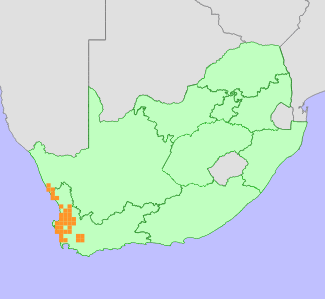|
Scientific Name | Leucospermum rodolentum (Salisb. ex Knight) Rourke |
Higher Classification | Dicotyledons |
Family | PROTEACEAE |
Synonyms | Leucospermum candicans Andrews |
Common Names | Beesbos (a), Klipboom (a), Knopbos (a), Kreupelbos (a), Pincushion (e), Sandluisie (a), Sandveld Pincushion (e), Sandveldluisiesbos (a), Sandveld-luisiesbos (a) |
National Status |
Status and Criteria | Near Threatened A2c |
Assessment Date | 2020/06/23 |
Assessor(s) | A.G. Rebelo, H. Mtshali & L. von Staden |
Justification | Leucospermum rodolentum is a widespread species with an extent of occurrence (EOO) of 28120 km² and an area of occupancy (AOO) of 1324 km². While it still persists at many locations it has experienced an estimated 20- 28% decline to the population since 1975 (three generations) due to agricultural expansion, water abstraction, and competition with alien invasive plants. It therefore nearly meets the threshold for Vulnerable under criterion A and is listed as Near Threatened. |
Distribution |
Endemism | South African endemic |
Provincial distribution | Northern Cape, Western Cape |
Range | Leucospermum rodolentum occurs on the lowlands of the West Coast of the Western Cape Provinces of South Africa with a few isolated populations also occurring in the Northern Cape. It is found from Namaqualand to Atlantis. |
Habitat and Ecology |
Major system | Terrestrial |
Major habitats | Saldanha Flats Strandveld, Swartland Alluvium Renosterveld, Breede Alluvium Renosterveld, Piketberg Sandstone Fynbos, Cederberg Sandstone Fynbos, Nardouw Sandstone Fynbos, Olifants Sandstone Fynbos, Graafwater Sandstone Fynbos, Breede Sand Fynbos, Cape Flats Sand Fynbos, Atlantis Sand Fynbos, Hopefield Sand Fynbos, Leipoldtville Sand Fynbos, Namaqualand Sand Fynbos |
Description | It occurs in sand fynbos and survives in arid areas by tapping deep water. Mature individuals are killed by fires, and only seeds survive. Seeds are released after ripening, and dispersed by ants to their underground nests, where they are protected from predation and fire. It is pollinated by insects. |
Threats |
| This species is severely threatened by expanding rooibos tea and potato cultivation between Hopefield and Heerenlogenmentsberg; and cereals and vines in Breede River Valley and Darling. A total of 43% of this species habitat has been lost to crop cultivation. Plants persist in natural vegetation strips between agricultural fields, but are exposed in chemicals used for pest control. This species is also impacted by water abstraction, and it is susceptible to drought related mortality. Recent field observations indicate that alien invasive plants are present in low densities in some parts of the range. Global climate change is a future potential threat. |
Population |
Leucospermum rodolentum is a widespread, common species, often encountered as dense stands within its habitat. It has however lost extensive habitat (43% in total), with at least 20-28% of this loss taking place in the past three generations from 1975 - 2020. It is extinct south of Kalabaskraal. Subpopulations are fragmented, and continue to decline due to ongoing habitat loss and degradation.
|
Population trend | Decreasing |
Conservation |
| It is not currently conserved in any formally protected area. |
Assessment History |
Taxon assessed |
Status and Criteria |
Citation/Red List version | | Leucospermum rodolentum (Salisb. ex Knight) Rourke | VU A2c | Raimondo et al. (2009) | |
Bibliography |
Goldblatt, P. and Manning, J.C. 2000. Cape Plants: A conspectus of the Cape Flora of South Africa. Strelitzia 9. National Botanical Institute, Cape Town.
Manning, J.C. and Goldblatt, P. 2012. Plants of the Greater Cape Floristic Region 1: The Core Cape Flora. Strelitzia 29. South African National Biodiversity Institute, Pretoria.
Raimondo, D., von Staden, L., Foden, W., Victor, J.E., Helme, N.A., Turner, R.C., Kamundi, D.A. and Manyama, P.A. 2009. Red List of South African Plants. Strelitzia 25. South African National Biodiversity Institute, Pretoria.
Rebelo, T. 2001. Sasol Proteas: A field guide to the proteas of southern Africa. (2nd ed.). Fernwood Press, Vlaeberg, Cape Town.
|
Citation |
| Rebelo, A.G., Mtshali, H. & von Staden, L. 2020. Leucospermum rodolentum (Salisb. ex Knight) Rourke. National Assessment: Red List of South African Plants version 2024.1. Accessed on 2025/10/28 |
 Comment on this assessment
Comment on this assessment

